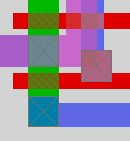

|
Magic Mailing List |
|
From: cfk (cfk AT pacbell DOT net) Date: Sun Mar 02 2003 - 16:23:16 EST
Dear Philippe:
I dont want to seem argumentative, but, I know its not a dual painting
issue. I can issue a 'see no', 'see nwell', see pwell' and see that the
nwell and pwell regions are appropriate. I can also see that after I issue a
'see metal1' that the metal1 shows as grown out from the side of the invf100
cell that was previously placed in my layout with getcell. At this point, I
have to believe it either is an issue with my understanding of Magic's DRC
vis a vis a placed subcell, or a 7.2 issue. I tend to believe the former,
but I really dont know yet. Maybe there is something wrong with the cells.
Would you mind looking at one of them if you get a chance at the Univ Kans
web site. The one I am concentrating on is invf100.mag (the inverter).
----- Original Message -----
From: "Philippe Pouliquen" <philippe AT alpha DOT ece.jhu.edu>
To: <magic-dev AT csl DOT cornell.edu>
Sent: Sunday, March 02, 2003 12:51 PM
Subject: Re: cursors & grids take 2
> Hi Charles,
>
> > I am currently trying to understand why when I place a cell such as the
> > simplest one INVF100.mag and add paint for just the Vdd or GND
> > connection on metal1 using the box (so its 8 units wide), I get three
> > errors pointing me at P-Well spacing of at least 9 and width of P-Well
> > of at least 10. Thats with a GND metal1 paint, I get a corresponding set
> > of errors with a Vdd metal1 paint for N-Well on the top of the cell.
>
> If you are using the middle button on the mouse to paint, then the most
> likely explanation is that the metal1 that you are clicking on also has
> nwell (or pwell) under it. The result is that you end up painting both
> metal1 and nwell (or pwell).
>
> Then, since the box you are painting is smaller than 10 units you get a
> width error on the nwell (pwell), and probably you are just a few units
> away from the other nwell in the cell, so you get the separation error as
> well.
>
> If this is the case, the solution is to either not paint the nwell (or
> pwell), or to make the painted nwell large enough and join it to the
> existing well.
>
>
> Philippe Pouliquen
> The Johns Hopkins University
>
>
|
|
|

|